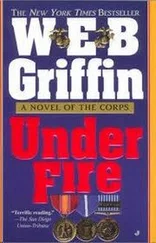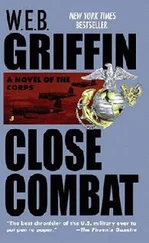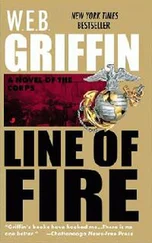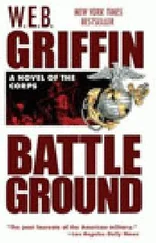W.e.b. Griffin - The Corps II - CALL TO ARMS
Здесь есть возможность читать онлайн «W.e.b. Griffin - The Corps II - CALL TO ARMS» весь текст электронной книги совершенно бесплатно (целиком полную версию без сокращений). В некоторых случаях можно слушать аудио, скачать через торрент в формате fb2 и присутствует краткое содержание. Жанр: prose_military, на английском языке. Описание произведения, (предисловие) а так же отзывы посетителей доступны на портале библиотеки ЛибКат.
- Название:The Corps II - CALL TO ARMS
- Автор:
- Жанр:
- Год:неизвестен
- ISBN:нет данных
- Рейтинг книги:4 / 5. Голосов: 1
-
Избранное:Добавить в избранное
- Отзывы:
-
Ваша оценка:
- 80
- 1
- 2
- 3
- 4
- 5
The Corps II - CALL TO ARMS: краткое содержание, описание и аннотация
Предлагаем к чтению аннотацию, описание, краткое содержание или предисловие (зависит от того, что написал сам автор книги «The Corps II - CALL TO ARMS»). Если вы не нашли необходимую информацию о книге — напишите в комментариях, мы постараемся отыскать её.
The Corps II - CALL TO ARMS — читать онлайн бесплатно полную книгу (весь текст) целиком
Ниже представлен текст книги, разбитый по страницам. Система сохранения места последней прочитанной страницы, позволяет с удобством читать онлайн бесплатно книгу «The Corps II - CALL TO ARMS», без необходимости каждый раз заново искать на чём Вы остановились. Поставьте закладку, и сможете в любой момент перейти на страницу, на которой закончили чтение.
Интервал:
Закладка:
Three days later, Holcomb wrote to Samuel W. Meek, an executive of Time-Life, and a personal friend. After discussing an article someone planned to write for Life about the Marine Corps, and expressing the hope that "Mr. Luce (Henry Luce, founder of Time and Life, was then functioning as the supreme editor of the Time-Life empire) will be willing to suppress it," he turned to the subject of Donovan:
The Donovan affair is still uppermost in my mind. I am terrified that I may be forced to take this man. I feel that it will be the worst slap in the face that the Marine Corps was ever given because it involves bringing into the Marine Corps as a leader in our own specialty that is, amphibious operations. Because commander [sic] work is simply one form of amphibious operation. It will be bitterly resented by our personnel, both commissioned and enlisted, and I am afraid that it may serve to materially reduce my usefulness in this office, if any, because I am expected, and properly so, to protect the Marine Corps from intrusions of this kind.
Five days after this, the Commander in Chief, United States Fleet (Admiral King), sent a priority, SECRET radio message to the Commander in Chief, Pacific Fleet, Admiral Chester W. Nimitz:
DEVELOP ORGANIZATION AND TRAINING OP MARINE AND NAVAL UNITS OF "COMMANDO" TYPE FOR USE IN CONNECTION WITH EXPEDITIONS OF RAID CHARACTER FOR DEMOLITION AND OTHER DESTRUCTION OF SHORE INSTALLATIONS IN ENEMY HELD ISLANDS AND BASES X
Admiral Nimitz promptly ordered the Commanding General, Second Joint Training Force, San Diego, to form four company-sized commando units. He wrote that he had requested the transfer of destroyer-transports from the Atlantic Fleet to the Pacific Fleet, for use with the commando units. He also "authorized and directed" General Vogel to "request the services of any personnel who may be familiar with training, organization, and methods of foreign commando units."
Lieutenant Colonel Evans F. Carlson was shortly thereafter named commanding officer of the 2nd Separate Battalion, Camp Elliott, San Diego, California (which was to be shortly renamed the 2nd Raider Battalion), and Captain James Roosevelt was named as his deputy'.
And on February 16, 1942, Major General Holcomb finally heard from Colonel William J. Donovan. It had nothing to do with Commandos, Raiders, or his becoming a Marine general. Navy personnel officers, desperate for officers, were scraping the bottom of the barrel and had informed Donovan that they intended to reassign some of the Navy and Marine officers assigned to COI.
Donovan made a reasoned, concise plea not to have the officers he was about to lose replaced by "a random selection of reserve or retired officers who would I am sure fall far short of our needs."
If Major General Holcomb replied to Donovan, that letter is still buried in a dusty file someplace. But for the rest of the war, the Marine Corps was far more cooperative than any other service when it came to furnishing personnel to Colonel (later Major General) Wild Bill Donovan's Office of Strategic Services. They included such people as Captain John Hamilton, USMCR, better known as actor Sterling Hayden, and screenwriter Peter Viertel, Captain, USMCR… But that's still another story…
Preface
The first surrender of United States military forces in World War II-the first time, in fact, since the Civil War that American military forces went forward under a white flag to deliver American soil over to an enemy-took place on a tiny but militarily useful dot of volcanic rock in the Pacific Ocean, Wake Island, shortly after the Japanese struck the U.S. Pacific Fleet at Pearl Harbor, Hawaii.
In 1939, with war on the horizon, the U.S. Navy began to pay particular attention to the tiny atoll in the middle of the Pacific. This almost infinitesimal U.S. possession was 450 miles from the Bikini atoll; 620 miles from the Marshalls, which the Japanese would certainly use for military purposes; 1,023 miles from Midway Island; and 1,300 miles from Guam. The USS Nitro was ordered to Wake to make preliminary engineering studies with a view to turning the atoll into a base for land (which of course included carrier-based) aircraft and submarines, and to fortify the island against any Japanese assault.
In 1940, Congress appropriated the funds. On 19 August 1941, 6 officers and 173 enlisted then of the 1st Defense Battalion, USMC, were put ashore on Wake Island from the USS Regulus. The first of what would be about 1,200 construction workers landed a few days later, and in October, Major James P. S. Devereux, USMC, arrived from Hawaii to take command.
Devereux brought with him two five-inch Naval cannon (which had been removed from obsolescent and scrapped battleships); four three-inch antiaircraft cannon (only one of which had the required fire-control equipment); twenty-four.50-caliber machine guns; and a large number (probably about one hundred) of air- and water-cooled.30-caliber Browning machine guns. And, of course, a stock of ammunition for his ordnance.
Nine Marine officers and two hundred enlisted then from the Navy base at Pearl Harbor arrived on 2 November 1941, bringing the strength of the 1st Defense Battalion to approximately half of that provided for in the table of organization and equipment. On 28 November 1941, Commander Winfield Scott Cunningham, USN, was detached from the aircraft tender USS Wright (after the Wright Brothers) with nine Navy officers and fifty-eight sailors to Wake to take control of the air station already under construction.
As senior officer, Cunningham replaced Devereux as Commander of United States Forces, Wake Island.
A five- thousand-foot runway was completed, and U.S. Army B-17 aircraft began to use Wake Island as a refueling stop en route to Guam, although it was necessary to fill the aircraft tanks by hand-pumping avgas from fifty-five-gallon barrels.
On 3 December 1941, the USS Enterprise launched at sea twelve Grumman F4F fighters, of Marine Fighter Squadron VMF-211, under Major Paul Putnam, USMC. They landed on the Wake Island landing strip that afternoon, and steps were immediately taken to begin bulldozing revetments for the aircraft.
On Sunday, 7 December 1941 (Saturday, 6 December 1941 in Hawaii) Major Devereux gave his command the day off. His Marines swam in the surf, played Softball, and many of them- most of the young, recently recruited enlisted men-hurried to complete letters home. The letters would be carried to civilization aboard the Pan American Philippine Clipper moored in the lagoon, which would take off at first light for Guam. (Pan American had been using Wake as a refueling stop).
Reveille sounded at 0600, 8 December 1941. While the Marines had their breakfast, the Pan American crew prepared the Philippine Clipper for flight.
At 0650, the radio operator on duty at the air station communications section, attempting to establish contact with Hickam Field, Hawaii, began to receive uncoded messages, which did not follow established message-transmission procedures, to the effect that the island of Oahu was under attack. He informed the duty officer, who went to Major Devereux.
At 0655, the Philippine Clipper rose from the lagoon and gradually disappeared from sight in the bright blue morning sky.
When he was told of the "Oahu under attack" message, Major Devereux attempted to contact Commander Cunningham by telephone, but there was no answer.
When he hung up the telephone, it immediately rang again. It was the communications shack; there was an urgent message from Hawaii, now being decoded.
"Has the Clipper left?"
"Yes, sir."
"Call it back," Devereux ordered, and then sent for his field music-his bugler.
"Yes, sir?"
"Sound 'call to arms,' " Major Devereux ordered.
Admiral Husband Kimmel's Pacific Fleet, and the navy base at Pearl Harbor, had been grievously wounded by the Japanese attack on December 7, 1941, but that is not the same thing as destroyed. The battleship force of the Pacific Fleet had been essentially wiped out at its moorings ("Battleship Row") at Pearl Harbor, together with a number of other men-of-war and supply ships, and there had been great loss of aircraft and materiel.
Читать дальшеИнтервал:
Закладка:
Похожие книги на «The Corps II - CALL TO ARMS»
Представляем Вашему вниманию похожие книги на «The Corps II - CALL TO ARMS» списком для выбора. Мы отобрали схожую по названию и смыслу литературу в надежде предоставить читателям больше вариантов отыскать новые, интересные, ещё непрочитанные произведения.
Обсуждение, отзывы о книге «The Corps II - CALL TO ARMS» и просто собственные мнения читателей. Оставьте ваши комментарии, напишите, что Вы думаете о произведении, его смысле или главных героях. Укажите что конкретно понравилось, а что нет, и почему Вы так считаете.









